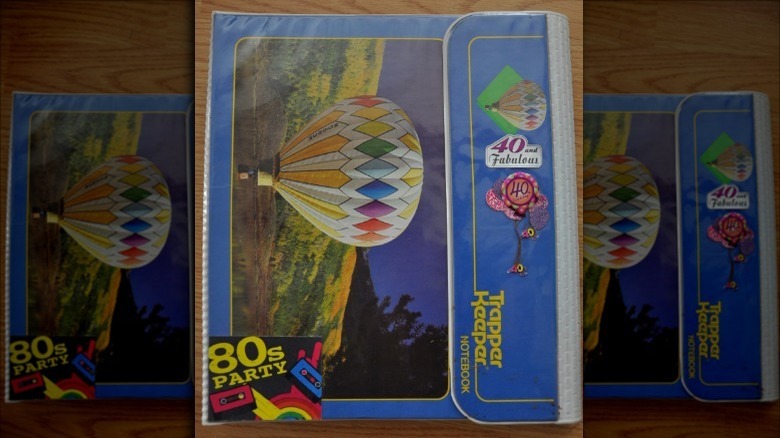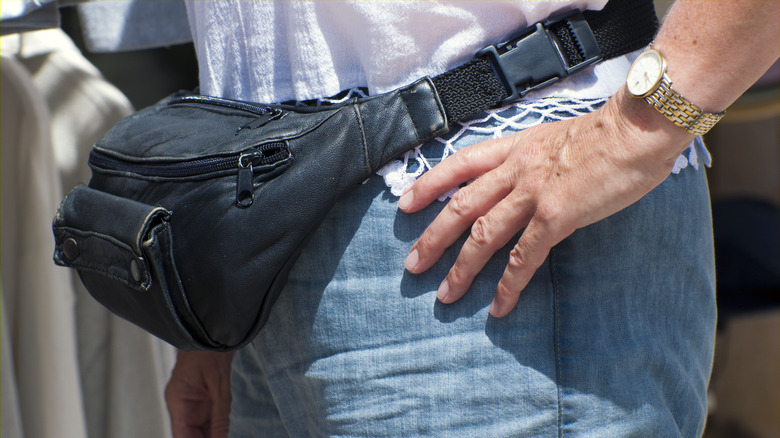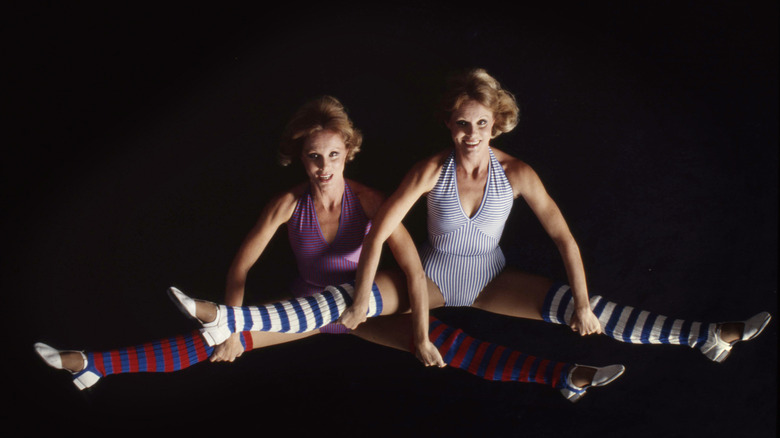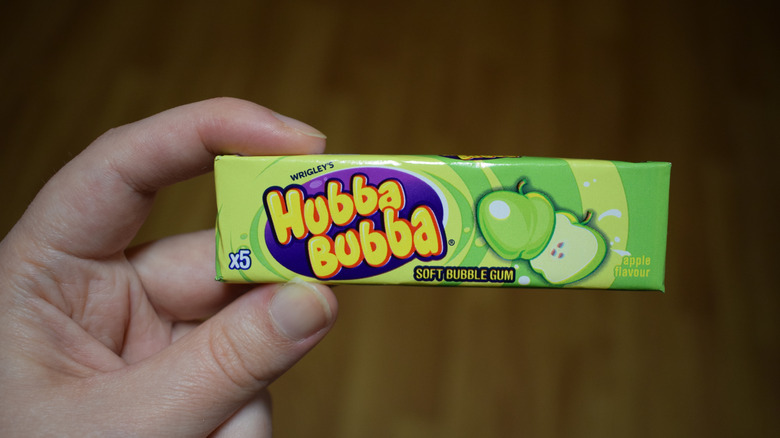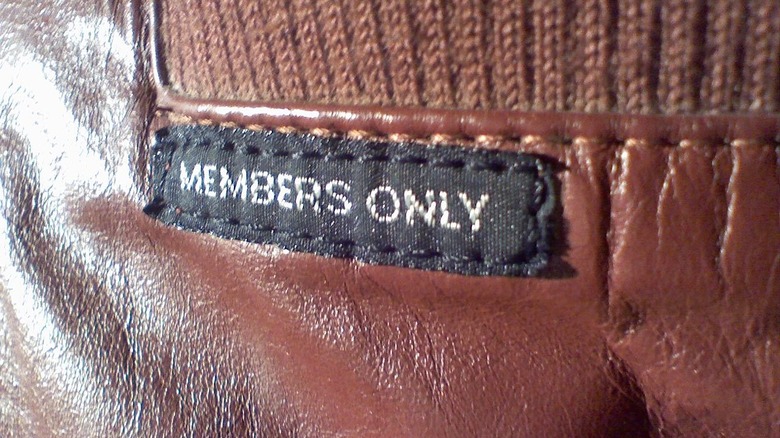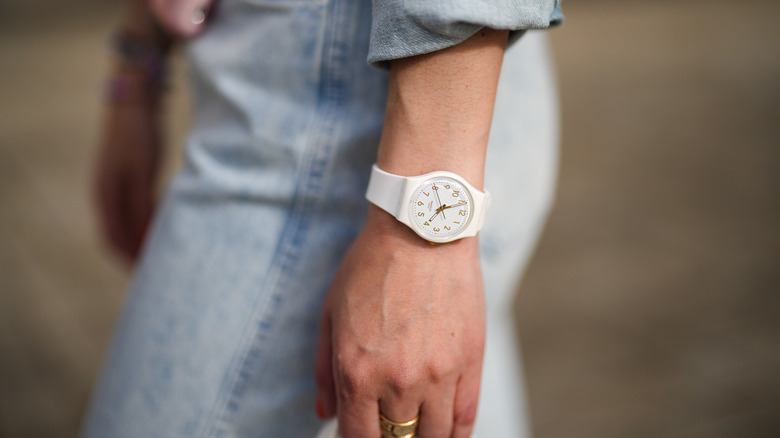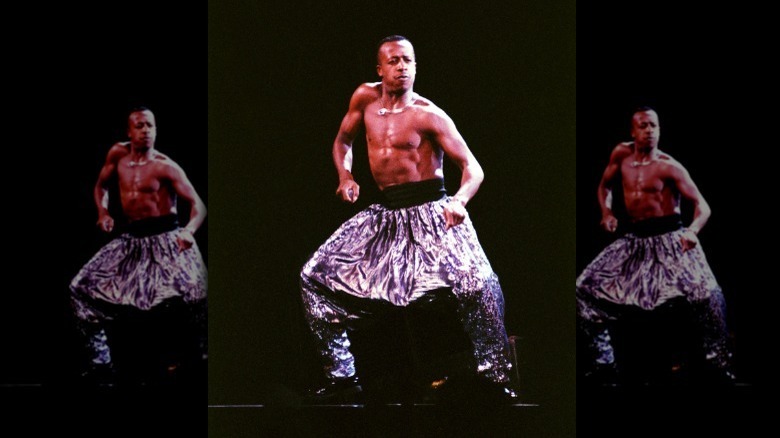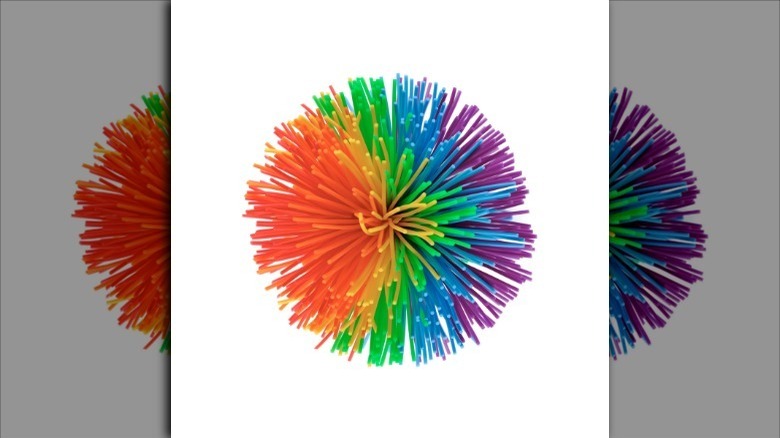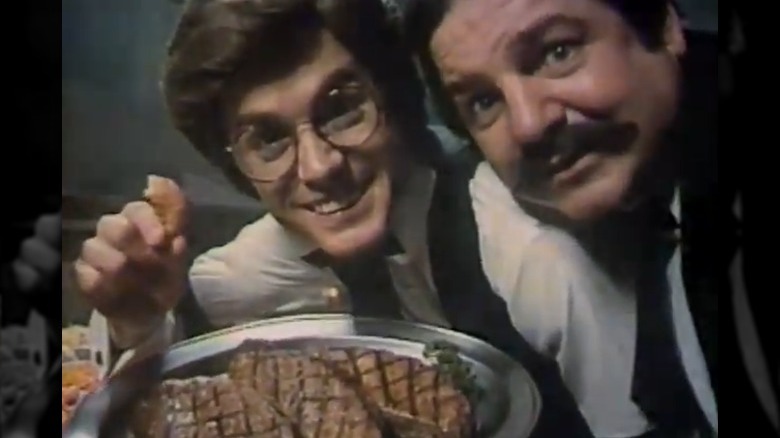Popular Things From The 1980s You Don't See Anymore
Thanks to shows like "Stranger Things" and "The Goldbergs," it seems like the 1980s were just a few short years ago instead of over 40 years in the past. The kids riding around suburban subdivisions on their dirtbikes are now in their 50s and standing on their lawns, shaking their fists at Generation Alpha kids (yup — we've wrapped the alphabet and started over).
The 1980s were iconic in terms of fashion and design — though it should be noted that "iconic" doesn't necessarily mean "good." This was the decade of the mullet, after all — an iconic hairstyle, but definitely not a good one. What's kind of freaky is how many things that were incredibly popular in the 1980s have now virtually vanished from the planet. It boggles the mind to think that, at one point, literally everyone knew these things, and now they exist mainly as ghostly images on the Internet and dusty exhibits in people's collections.
What's interesting is the fact that most of these things aren't "bad." Most were really useful and even kind of cool. The mystery isn't why they were so popular in the first place — it's why everyone stopped using them, seemingly the moment the ball dropped at the end of 1989. For your consideration, here are some popular things from the 1980s you don't see anymore.
Trapper Keepers
If you were in school in the 1980s, you either had a bunch of Trapper Keepers or you were home-schooled in a very unhappy environment. The things were literally everywhere. And technically they're not gone — according to Fox 8 News, Mead relaunched the Trapper Keeper line in 2021 in hopes of cashing in on 1980s nostalgia with what is actually an incredibly useful school supply.
Launched in 1978, the Trapper Keeper was — unbelievably — the first time anyone marketed an organizational tool to students. Prior to that, kids either came up with a home-brew solution or (more commonly) wandered the halls of their schools with a mass of confusing and disorganized assignments. As Mental Floss notes, the Trapper Keeper was also colorful and graphic, and solved a simple problem: papers falling out of your folders. It was also the result of painstaking market research that showed that kids were taking more classes and were buying more portfolios to keep up with their workload.
It was an immediate hit, and Trapper Keepers of all kinds of styles and designs hit the market. And then, as noted by journalist Whet Moser, schools began to ban them for being too large for desks, too small for handouts, and too annoying because kids played with the Velcro latch constantly. At the same time, store shelves shrank, and the Trapper Keeper no longer fit. By the late-1990s, the iconic folders were basically gone.
Fanny packs
The fanny pack remains a fixture in our imaginations — if you want to suggest that a fictional character is a bit of a nerd, you put a fanny pack on them. It's an article of clothing that simply cannot be cool.
Known as a "bumbag" outside the United States, InStyle reports that its modern incarnation dates back to 1954, when it was marketed primarily to skiers in Europe. When it made its way to the U.S. in the 1980s, there went any sense of cool or style: As noted by GARAGE, 1980s fanny packs were utilitarian from the get-go, made from nylon or similarly durable material and embraced by those fashion voids known as tourists. In other words, you didn't wear a fanny pack because it was fashionable (it never was). You wore one because it was a good place to store your stuff while on the run.
According to Mel Magazine, the fanny pack was part of the first wave of "athleisure" fashion, where clothing that had been relegated to the gym was brought to other areas of our lives — that's one reason people in the 1980s started wearing track suits, like, everywhere. Once people started wearing their gym clothes out to dinner, fanny packs just naturally followed.
There was, of course, a backlash. Once it was everywhere, whatever cool factor attached to it faded, and by the 21st century, the fanny pack was a joke.
Pagers
Back in the 1980s, you didn't have to be a drug dealer to own and use a pager. In a world without cell phones, the pager was the most convenient way to ensure people could reach you — or at least alert you to the fact that they wanted to reach you.
Pagers go back way past the 1980s, though — Healthtech Magazine notes the pager was invented by Al Gross in 1949, and the first paging systems were introduced in the 1950s. But original pagers were limited to a small geographic area, which is why they were most commonly found in hospitals, which used them to alert doctors and nurses to emergencies. It wasn't until "wide-area" paging was invented in the 1980s that "beepers," as they were sometimes called, became a fad.
As noted by Quartz, a big driver behind the adoption of pagers by kids in the 1980s was the fact that schools moved quickly to ban them. Suddenly, having a pager wasn't just necessary if your mom needed to tell you she'd be late picking you up from practice — they were rebellious. When two-way pagers came out, they enjoyed a brief moment of being a necessary celebrity accessory — and then the cell phone came along and the pager went right back into the hospitals — where HealthTech Magazine tells us they remain widely used.
Leg warmers
As noted by Bustle, you can pretty much peg the explosion of the leg warmer — essentially socks for your lower legs — to the film "Flashdance." Although, as The Vintage Woman reports, Jane Fonda made a splash in 1979 when she wore them in a "Vogue" pictorial, it was the movie that really made the fad explode. Released in 1983, its dancer protagonist sure made wearing leg warmers look cool.
This was part of a larger trend. The Atlantic notes that athletic clothing has been influencing fashion since at least the 19th century; as clothing has become less formal, a desire to at least appear healthy has risen, and synthetic materials have become preferable to natural fabrics. The personal fitness explosion sparked the trend of dressing like an athlete even if you got winded standing up from the couch. According to Ballet Box, leg warmers were traditionally used by dancers to keep their leg muscles warm and loose between routines. Leg warmers were quickly co-opted into wider use when every woman in the world decided she wanted to look like a dancer.
Like any fashion fad, leg warmers began to fade pretty quickly. They're still worn by dancers and by folks who are actually working out, but you rarely see them as just part of an everyday streetwear look.
Video Game Arcades
According to The Strong Museum of Play, in 1981 there were about 24,000 full video game arcades in the United States — and that doesn't count places that weren't dedicated arcades but had video game cabinets. The Verge explains that the introduction of microprocessors and high-quality color graphics in the late 1970s led to the first video game sensation, "Space Invaders" — which led directly to the creation of the arcade. "Space Invaders" was so popular in Japan, arcades were opened that were stocked with just that game and nothing else.
If you watch films or TV shows with teen characters from the era, you will inevitably see a scene set inside an arcade. They were everywhere, and every kid in the country spent some time inside one, plugging their allowances into machines one quarter at a time. Even the introduction of home video game consoles like the Atari 2600 couldn't hurt the arcade business. Arcade games were way ahead of those consoles in terms of graphics and gameplay.
Over time, of course, those home gaming consoles got better, and there was less and less need to plug quarters into a machine when you could have a similar gaming experience in your room for a one-time cost. According to Arcade Heroes, there are just 2,500 dedicated arcades left in the U.S., and there's no doubt that the unique subculture of the video game arcade is long dead.
The Bubble Gum Wars
What's that you say? You're unaware of the global conflict known as The Bubble Gum Wars? If you were a kid during the 1980s, you lived during a Golden Age of bubble gum. As explained by Retro Junk Archive, Bubble Yum was introduced in 1975 as the first-ever soft bubble gum, and Bubblelicious (that was really the name) and Hubba Bubba (that was also a real, actual product name) were quickly introduced to compete.
Bubble gum was a thing back in the 1980s. As noted by The New York Times, it was a huge and apparently recession-proof market, and the desperation to grab all that allowance money meant there was serious innovation in gum technology. One way to know that bubble gum was huge is the fact that the industry had its very own bizarre conspiracy theory — as reported by The New York Times, a rumor that Bubble Yum got its rubbery texture from the addition of spider eggs swept the nation, damaging sales and forcing Life Savers, Inc. to buy full-page newspaper ads dispelling the rumor.
The candy companies kept coming up with new ideas to try and shake up the market. This led to other iconic bubble gums like Big League Chew, which Esquire explains was invented in 1979 by a former baseball player and became controversial because it was viewed as a "gateway" to chewing tobacco, and Slimer — gum in a toothpaste tube (may God forgive us).
Members Only Jackets
If you're a costume designer for a TV show or movie and you're charged with making the audience believe they're being transported to the 1980s, there are a few items of clothing you'll always include: puffy sleeveless vests, frosted jeans — and at least one Members Only jacket.
The jacket remains so iconic and famous you are totally picturing it right now. According to Mental Floss, Herb Goldsmith came up with the design after being warned by clients of his family's apparel business that young men were rejecting traditional jacket designs. He was inspired by military-cut jackets, and he took the "Members Only" idea from exclusive clubs.
The jackets debuted in 1980, and they weren't exactly cheap. They cost $55 each, which would be close to $200 in today's money. But Goldsmith negotiated with retailers to have his jackets displayed in eye-catching cascading racks that showed off the jacket's unique design. The jackets quickly became popular among celebrities, which the company tried to capitalize on with a hilariously 1980s commercial starring soap opera star Anthony Geary.
Soon, the jackets were everywhere. Mel Magazine offers clues to the scale of the Members Only fad: By the early 1980s, the market was between $100 and $200 million. But it didn't last long — by the late 1980s and early 1990s, Members Only was a victim of its own success. So many people owned one, it couldn't possibly be cool any more, and sales dropped off a cliff.
Rubik's Cubes
According to Smithsonian Magazine, Ernő Rubik, a Hungarian architect, actually invented the Rubik's Cube in 1974, but WBUR's Only a Game notes that it didn't hit store shelves until 1980. Within a year, it was selling hundreds of millions of units, making it "the best-selling toy in history." Which is incredible considering it's a puzzle working with some fairly abstract mathematical concepts and was initially seen as a teaching tool. No one expected it to become so ... popular.
There's a chance are you're familiar with the Rubik's Cube but haven't actually seen one — possibly ever. The Cube's popularity seemed to vanish overnight in the early 1980s, in part because the puzzle was extremely frustrating for most people. After spending some time playing with it, folks would realize how much time and thought went into the solution, and toss it into a drawer and forget about. By 1982, The New York Times would call the Cube "a fad" and "passe."
The Rubik's Cube is still out there, of course — as reported by The New York Times, there's a dedicated community of "speedcubers" who seek to solve the puzzle as quickly as possible (the current record is 3.47 seconds). But the world where literally everyone had a Rubik's Cube (and Saturday Night Live would devote a minute of screen time to mocking it) is long gone.
Swatches
Two things you probably don't know about the Swatch: One, according to Click Americana, the name stands for "second watch" because they were intended to be cheap, disposable watches; and two, they were produced in an effort to save the Swiss watchmaking industry from destruction during something called the Quartz Crisis.
According to Montredo, Switzerland dominated the watch market for most of the 20th century. Most watches were mechanical, and Swiss watches were renowned for their craftsmanship. Then, in the 1970s, Japanese watchmaker Seiko launched the first successful Quartz watches. How Stuff Works explains that Quartz crystals are actually incredibly accurate compared to traditional mechanical watches. Within a decade, the Swiss watch industry was reeling, with tens of thousands of craftspeople out of work.
As Mental Floss explains, in 1983, Ernst Thomke, Elmar Mock, and Jacques Müller of ETA SA released the first Swatch — an inexpensive plastic watch with a reduced number of parts that could be mass-produced. Their key insight was making the Swatch into a fashion accessory — it came in different colors and styles, and people were encouraged to match different Swatches with different outfits. The Swatch was huge — sales hit $105 million by 1985, and the Swiss watch industry was saved — though it began to decline in popularity. Swatch still releases new designs, and some people still buy them — but you certainly don't see them anywhere any more.
Parachute Pants
Sometimes society just goes crazy, altogether, all at once. There's really no other possible explanation for the fact that parachute pants were really, really popular in the 1980s.
When you think of parachute pants — if you think of parachute pants — you probably think of MC Hammer dancing in some truly egregious examples. The artist became so associated with the trousers, in fact, that Mental Floss reports he actually advocates that they be referred to as Hammer Pants. As noted by author David Mansour in his book "From Abba to Zoom: A Pop Culture Encyclopedia of the Late 20th Century," they were loose and baggy with lots of room in the crotch, and often marked by an overabundance of zippered pockets. They were made from the same sort of nylon as parachutes — hence the name.
According to Wisegeek, they were popular among breakdancers in the 1980s because they allowed so much freedom of movement. As hip-hop and breakdancing became incredibly popular in the 1980s, the pants were soon everywhere — which, ironically, is why you never see them anymore. When the culture took a turn for grunge and gangster rap in the 1990s, parachute pants seemed hopelessly dorky and hopelessly tied to a bygone era.
Koosh Balls
The Koosh Ball — which Time named as one of the All-Time 100 Greatest Toys — doesn't seem like it has much going for it. A lightweight ball of rubber filaments around a solid core, People tells us that a guy named Scott Stillinger invented the Koosh Ball when his young children had trouble playing catch. He had the bright idea to create a ball that would be very easy for tiny hands to grab onto. The name "Koosh" approximated the sound that the ball made when you caught one.
Initially, retailers didn't know what to do with it; the Lodi News Sentinel notes that it was once referred to as "the pet rock of the 1980s." But the Koosh Ball became a bona-fide fad almost immediately. Stillinger sold 50 million within a few years, and Business Insider tells us that Hasbro bought the Koosh Ball in 1997 for a cool $100 million.
Since the late 1980s, the Koosh Ball is no longer a national phenomenon, largely because the balls don't actually do anything and aren't actually very good at being balls. But they're still widely used as a training device in Quickstart Tennis, according to the Western & Southern Open, and in his book "The Secret History of Balls," author Josh Chetwynd notes that the mighty Koosh is used as a therapy tool for children dealing with disorders ranging from autism to dyslexia.
Beefsteak Charlies
If you were alive in the 1980s, you probably saw a commercial for Beefsteak Charlie's — probably about a million times, as it ran constantly on local television stations. According to Retroist, it was once a real, normal restaurant in Manhattan, founded in 1910 and operated as a kind of hip steakhouse until its second owner, William Shoshnick, sold it in the late 1960s. Then, a guy named Larry Ellman took over the name and launched a chain of kitschy restaurants that were briefly incredibly — and inexlplicably — popular in the 1980s. In 1984, the chain had 68 locations and those constant commercials. By 1989, the chain was in bankruptcy.
A Washington Post review from 1982 explains its appeal: It was cheap, and it offered unlimited shrimp, salad, sodas, and ice cream. It was a pretty incredible deal, even if the food was "universally disappointing." As Bklyner notes, Beefsteak Charlies was kind of a precursor to places like T.G.I. Fridays and Applebees: It offered affordable meals with a little more ambiance than most fast food joints, its restaurants decked out like Victorian-era dining rooms.
The combination of low-quality food and a business model that offered unlimited fare for a low price proved to be unsustainable — as popular as the place was in the 1980s, it was pretty much gone by the 2000s.

